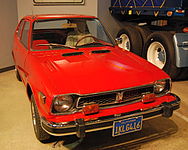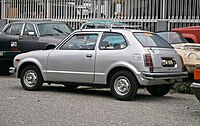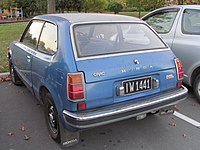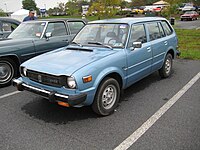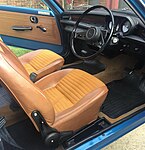
The Honda CR-X, originally launched as the Honda Ballade Sports CR-X in Japan, is a front-wheel-drive sport compact car manufactured by Honda from 1983 until 1991 with nearly 400,000 produced during this period. The first-generation CRX was marketed in some regions outside Japan as the Honda Civic CRX. Although there are many supposed definitions for the initialism CR-X, the most widely accepted is "Civic Renaissance Experimental".

The Honda Civic is a series of automobiles manufactured by Honda since 1972. As of 2023, the Civic is positioned between the Honda Fit/City and Honda Accord in Honda's global car line-up.

The Honda Accord, also known as the Honda Inspire in Japan and China for certain generations, is a series of automobiles manufactured by Honda since 1976, best known for its four-door sedan variant, which has been one of the best-selling cars in the United States since 1989. The Accord nameplate has been applied to a variety of vehicles worldwide, including coupes, station wagons, hatchbacks and a Honda Crosstour crossover.

The Honda Prelude is a sports car produced by the Japanese company Honda over five generations from 1978 to 2001. It is a two-door coupé that was loosely derived from the Honda Accord and was the first Honda to feature a moonroof, a feature that remained standard equipment throughout its production. The Prelude was used by Honda to introduce the Japanese Honda retail sales chain Honda Verno, with the international release of the model following shortly after. Production of the Prelude concluded in 2001 upon the introduction of the fourth-generation Integra. The Prelude name was originally trademarked by Toyota, but was amicably given to Honda for use. The Prelude complied with the series of music-themed vehicle names which Honda used at the time, along with the Accord, Quintet, Concerto, Jazz, and Ballade.

The Nissan Violet is a model of car that appeared in Japan in 1973, and was exclusive to Japanese Nissan dealerships called Nissan Cherry Store as a larger companion to the Nissan Cherry.

The Dodge Colt is a subcompact car that was manufactured by Mitsubishi Motors and marketed by Dodge for model years 1971 to 1994 as captive imports. Rebadged variants include the Plymouth Champ and Plymouth Colt, both were marketed by Plymouth.

The Triumph Acclaim is a front-wheel drive compact family saloon/sedan manufactured by British Leyland (BL) from 1981 to 1984. It is a locally built version of the Honda Ballade. It was the final vehicle marketed under the Triumph marque, and the first product of the alliance between BL and Honda which would last until the mid 1990s.

The Subaru Leone is a compact car produced by the Japanese car manufacturer Subaru from 1971 to 1994. The word leone is Italian for lion.

The Isuzu Gemini is a subcompact car produced by the Japanese automaker Isuzu from 1974 until 2000. The same basic product was built and/or sold under several other names, sometimes by other General Motors brands, in various markets around the world. While the first generation was of a rear-wheel drive design, later versions were all front-wheel-drive, and the last two generations were no more than badge-engineered Honda Domani until the name was retired in 2000.
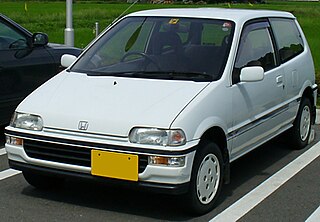
The Honda Today is a kei car produced by Japanese automaker Honda beginning in 1985. It was replaced by the Honda Life in 1998.

The Honda Logo is a B-segment supermini manufactured and marketed by Honda from 1996 to 2001, as a three-door and five door hatchback, sharing its platform with the Honda Capa and replacing the second generation Honda City. The Logo was larger than the kei class Honda Life, smaller than the subcompact Honda Civic, and was superseded by the Honda Fit.
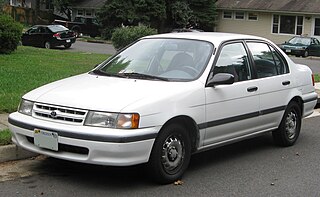
The Toyota Tercel is a subcompact car manufactured by Toyota from 1978 until 1999 across five generations, in five body configurations sized between the Corolla and the Starlet. Manufactured at the Takaoka plant in Toyota City, Japan, and sharing its platform with the Cynos and the Starlet, the Tercel was marketed variously as the Toyota Corolla II — sold at Toyota Japanese dealerships called Toyota Corolla Stores — and was replaced by the Platz in 1999. It was also known as the Toyota Corsa and sold at Toyopet Store locations. Starting with the second generation, the Tercel dealership network was changed to Vista Store, as its badge engineered sibling, the Corolla II, was exclusive to Corolla Store locations.

The first generation Honda City was a subcompact hatchback aimed mainly at the Japanese domestic market. The somewhat uniquely designed City, referred to by Honda as "Tall Boy" style, was also marketed abroad and was available in a number of versions. First introduced in November 1981, it carried the model codes AA for sedans, VF for vans, and FA for the widetrack Turbo II and Cabriolets. It was sold at the Honda Japan dealership sales channel called Honda Clio.

The second-generation Honda Civic is an automobile produced by Honda from 1979 until 1983. It debuted in June 1979 with a more angular shape, increased engine power, and larger dimensions in all models. The design was closer aligned to its larger sister, the Accord and the car was generally more comfortable and sophisticated than the first generation Honda Civic.

The third-generation Honda Civic is an automobile which was produced by Honda from 1983 until 1987. It was introduced in September 1983 for the 1984 model year. The Civic's wheelbase was increased by 2–5 inches (13 cm) to 93.7 inches (hatchback) or 96.5 inches (sedan). A three-door hatchback/kammback, four-door sedan, the five-door "Shuttle" station wagon, and sporting CRX coupé shared common underpinnings. This included MacPherson strut suspension with torsion bars in the front and a rear beam with coil springs. However, the body panels were largely different between models. The Civic-based Honda Quint five-door hatchback also underwent a model change, and became the Honda Quint Integra, available as both a three- and five-door fastback. The Quint Integra was sold at the Japanese Honda Verno dealership along with the CR-X. The Civic in Japan was now exclusive to Honda Primo, along with Honda's kei cars as well as superminis like the Honda City.

The fourth-generation Honda Civic is a Japanese sub-compact automobile. It was produced by Honda from 1987 until 1991 with the wagon continuing in production in some markets until 1996. The suspension had a new double-wishbone suspension in the front and an independent suspension in the rear, the wheelbase was increased to 250 centimetres (98 in) from that of the third-generation Civic, and the body was redesigned with a lower hood line and more glass, resulting in less drag. The redesigned Civic was introduced in 1987 for the 1988 model year. The fourth-generation Civic would be available in three variants; 3-door hatchback, 4-door sedan and 5-door wagon with various trim levels offered in each variant.

The sixth-generation Honda Civic is an automobile produced by Honda from 1995 until 2000. It was introduced in 1995 with 3-door hatchback, 4-door sedan and 2-door coupe body styles, replicating its predecessor's lineup. The sixth-generation Civic offered two new 1.6-liter 4-cylinder engines and a new continuously variable transmission (CVT) on the HX model. The coupe and sedan are 2.3 in (58 mm) longer and the hatchback is 4.3 in (109 mm) longer than the previous-generation Civic. This was the last generation of Civic to have front double-wishbone suspension, as the succeeding seventh generation would change the front suspension to a MacPherson strut.

The seventh-generation Honda Civic is an automobile produced by Honda from 2000 until 2005. It debuted in September 2000 as a 2001 model. Its exterior dimensions stayed similar to the outgoing predecessor, with interior space significantly increased, bumping it up to the compact car size designation. A notable feature was the flat rear floor that gave better comfort to the rear seat passengers. This generation abandoned the front double wishbone suspension, used previously from fourth to sixth generations, replacing it with MacPherson struts. This generation was the last to offer 4WD variants.

The Honda Vigor is a premium sedan that was derived from the Honda Accord. It was sold in Japan through the Honda Verno dealer network from 1981 until 1995, and sold in North America from June 1991 until 1994 as the Acura Vigor. Early Vigors were more upmarket versions of the Accord, and served as Honda's flagship until the arrival of the Honda Legend. In 1989, the Vigor would differentiate itself further from the Accord with unique styling and an available longitudinal five-cylinder engine, and a twin to the Vigor was introduced with the Honda Inspire, available at Honda Clio dealerships.

The tenth-generation Honda Civic(FC/FK) is a compact car (C-segment) manufactured by Honda from 2015 until 2022, replacing the ninth-generation Civic. It was first released in November 2015 in the North American market, followed by its introduction in Europe and Asia-Pacific in 2016, and in Japan in 2017. This generation marked the unification of the Civic range, as Honda ceased making a dedicated version for the European market—a strategy employed since the seventh-generation Civic—in favour of a globally marketed model. As the result, three body styles were introduced with a near-identical design which are sedan, hatchback, and coupe.





